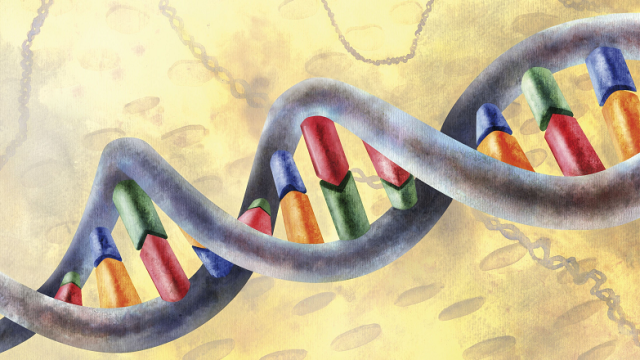Yesterday the Royal Swedish Academy of Sciences awarded the Nobel Prize in Chemistry to Tomas Lindahl, Aziz Sancar, and Paul Modrich for their work in mapping out how cells repair damaged DNA. Their research improved our understanding of how our own cells work and helped in the development of cancer treatments, but what does it all really mean?
Here’s Your Genetics Review

Real DNA isn’t quite this neat-looking. Image credit: Getty Images
The instructions for growing an organism — you, for example — are contained in a molecule called deoxyribonucleic acid, better known as DNA, which is stored in the nucleus of every cell in your body. DNA contains a genetic code that tells each cell what type of cell to become and what to do with itself. The genetic code isn’t written in letters or digits; it’s written in chemicals. The four amino acids that spell out your genome are adenine, cytosine, guanine, and thymine. All the complex instructions for your body’s development can be spelled out with different sequences of these four molecules.
You’ve probably noticed that DNA looks a bit like a twisty ladder (scientists call it a double helix, but “twisty ladder” is more fun). The sides of the ladder are made up of sugars and phosphates, and the rungs are made up of pairs of the four amino acids that spell out the genetic code.
Here’s how it all fits together. Each animo acid binds with a sugar molecule and a phosphate molecule; together, they form a building block called a nucleotide (remember nucleotides; we’ll be talking about them again later). The nucleotides line up, so that the phosphate in one nucleotide binds with the sugar in the next nucleotide to form a long strand.
Amino acids bind with each other to form the rungs of the ladder, and the phosphates and sugars attached to them bind to form the other side of the ladder. When your cells divide, they need to make a copy of your DNA for the new cell’s nucleus, so molecules in your cells pull apart the double helix and use each half as a template for a new strand of DNA. A related molecule called RNA helps with this transcription process. Because adenine always binds with thymine, and cytosine always binds with guanine, DNA replication produces two identical DNA molecules — as long as nothing goes wrong.
If that last part sounds a little ominous, don’t worry too much.
Repair Systems in Your Cells
DNA is your blueprint, firmware, and operating system all rolled into one, so of course it’s really important for the code to be correct. But the nature of chemistry is that things sometimes go wrong at random. DNA breaks down over time, sometimes there are mistakes in transcription, and ultraviolet radiation and some chemicals can damage DNA. But the body has ways to fix that.
Specialised protein molecules called enzymes act as chemical repair mechanisms for DNA. We understand several of those mechanisms in great detail, down to the chemical reactions between molecules, thanks to the three Nobel Chemistry laureates, Tomas Lindahl, Aziz Sancar, and Paul Modrich. Because scientists now understand how cells repair damaged DNA, they also have a better understanding of the chemistry behind the ageing process, some neurodegenerative diseases, and several types of cancer. That, in turn, can help develop more effective medical treatments.
In other words, the chemistry of DNA damage and repair is pretty important, and that’s why Lindahl, Sancar, and Modrich won this year’s Nobel Prize in Chemistry. They worked independently over the years, rather than collaborating on a shared project, so let’s look at their Nobel-worthy work individually.
Tomas Lindahl and DNA Decay
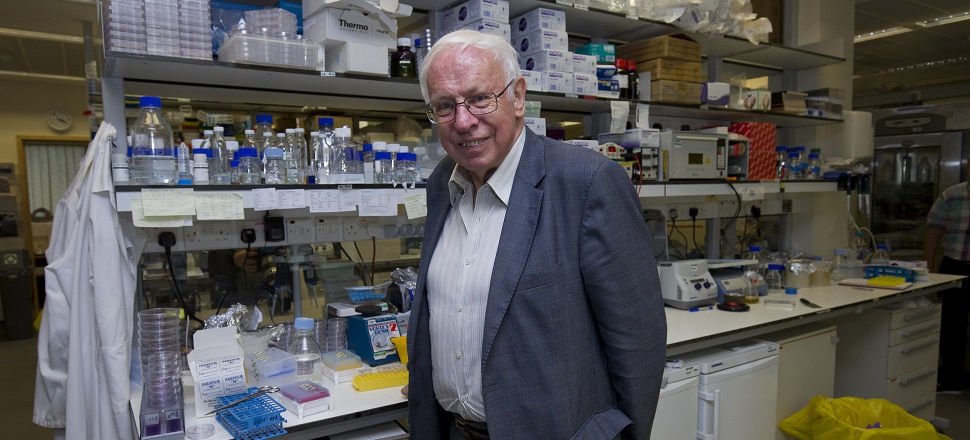
Thomas Lindahl. Image credit: Getty Images
Until the early 1970s, scientists were comfortably sure that DNA was stable. The fact that life existed at all seemed like good evidence of that. Evolution depends on occasional mutations, because mutations help create enough variety for natural selection to work on, but moderation is key. If genetic information changed too much, too often, it would be impossible for multi-cellular life forms to evolve in the first place. Imagine trying to build a house with a blueprint whose lines keep moving, or trying to run an app whose software code keeps changing. Life would never get anywhere.
But in the early 1970s, while Lindahl was doing his postdoctoral research at Princeton University, he happened to need to heat a sample of RNA, a molecule similar to DNA which also carries genetic information. RNA is only a single strand, not a double helix like DNA, and it uses a base called uracil instead of thymine. In some viruses, RNA takes the place of DNA, and it carries all of the virus’ genetic code. In your cells, and the cells of most other organisms, it helps in the process of replicating DNA.
Lindahl noticed that RNA molecules degenerated very quickly when he heated them. That made him wonder how stable DNA could really be, if RNA was so vulnerable. Years later, while working at the Karolinska Institutet in Sweden, Lindahl was able to prove that DNA did, in fact, decay over time, slowly but steadily. That discovery is part of the reason he won this year’s Nobel Prize.
The human genome is damaged thousands of times every day. With that kind of “DNA decay,” as Lindahl put it, the genetic code shouldn’t be stable enough to have allowed life to evolve — or persist. Since life obviously exists, cells must have some way to repair the constant damage to DNA.
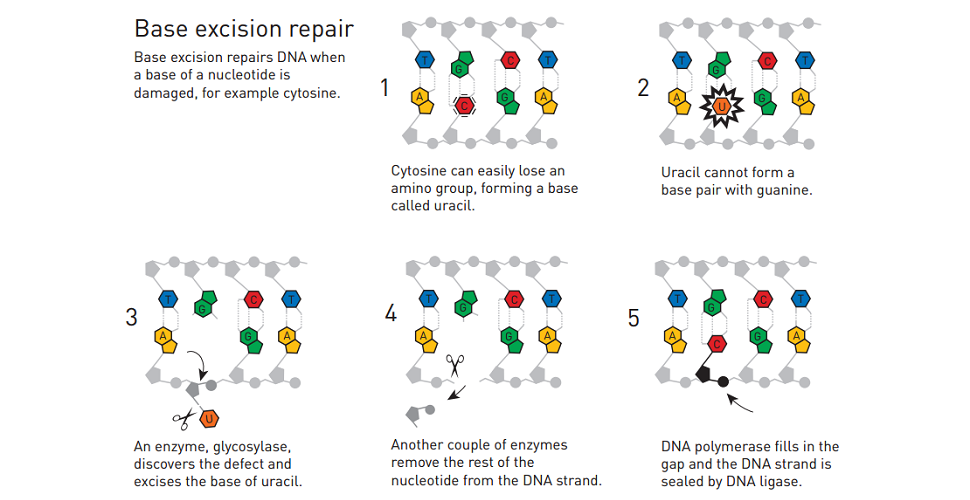
Base Excision Repair. Image credit: Royal Swedish Academy of Sciences
Cytosine, one of the four base pairs that helps spell out the genetic code, often loses a piece called an amino group. Without that piece, cytosine becomes a different base: uracil. Remember that cytosine binds with guanine, but uracil (which is one of the bases in RNA) binds with adenine. And during DNA transcription, adenine binds with thymine. That creates a DNA molecule with a different code than the original: a mutation.
Lindahl discovered an enzyme called uracil-DNA glycosylase (UNG), which recognises the uracil and cuts it out of the DNA strand. Other enzymes cut out the rest of the uracil’s nucleotide, and then DNA polymerase comes along and plugs in a new nucleotide with a cytosine base. DNA ligase seals up the strand, and it’s as good as new.
He named the process base excision repair and published the discovery in a 1974 paper, and that’s the other half of the reason Lindahl is now a Nobel laureate. Over the next 35 years, he found and studied many other types of glycosylase. In 1996, he managed to recreate the whole process in cultured samples of human cells.
Aziz Sancar and Repairing UV Damage

Aziz Sancar. Image credit: Getty Images
As if it weren’t unnerving enough that DNA just breaks down on its own and has to be repaired a few thousand times a day, it’s also vulnerable to damage from outside sources, like ultraviolet radiation. Here’s one way that works:
If there are two thymine bases sitting next to each other in the sequence, UV radiation can cause them to bind with each other, forming pairs called dimers, instead of with the adenine bases across from them. It’s basically the chemical equivalent of a double date gone wrong, and it puts a stop to DNA synthesis.
In the 1940s, scientists noticed that bacteria exposed to lethal doses of UV radiation could recover under plain old blue light, but they weren’t sure why. Biologists called it photoreactivation. About thirty years later, this mystery caught the attention of a young biochemist named Aziz Sancar, along with several other researchers.
Renato Dulbecco suggested that photoreactivation relied on an enzyme, and Stanley Rupert proved him right by discovering an enzyme called photolyase and demonstrating that it worked to repair UV damage to DNA in bacteria. But no one was yet sure exactly how photolyase worked.
In 1978, Sancar found and cloned the gene that coded for photolyase. He even managed to modify bacteria in a culture to produce more photolyase than they would naturally. That research earned Sancar his PhD, but he didn’t come back to photolyase again until 1984, when he worked at the University of North Carolina, Chapel Hill. Then, in a series of papers over the next few years, he described the chemistry that made the enzyme work.
Photylase is able to repair damaged DNA when it’s exposed to visible light because it can absorb light and convert its energy into a chemical reaction that splits thymine dimers. That’s the chemistry behind photoreactivation, and unravelling it helped earn Sancar his Nobel Prize.
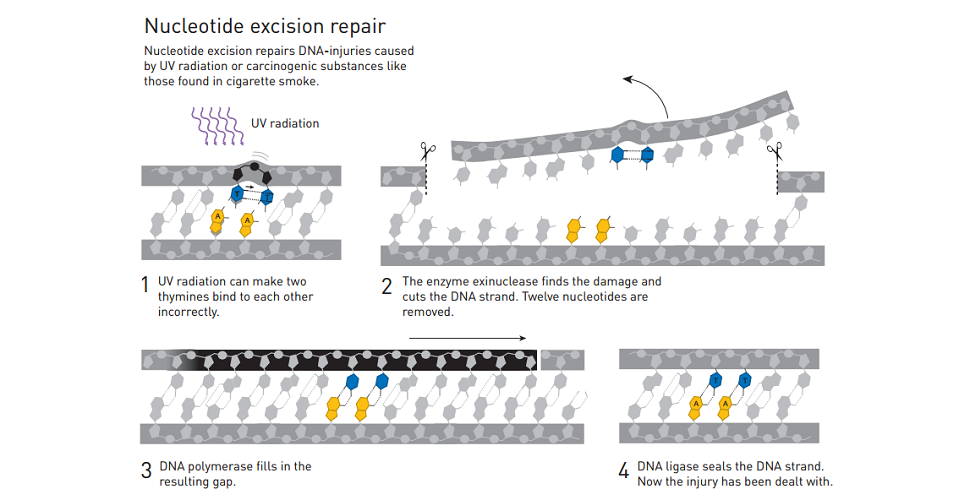
Nucleotide Excision Repair. Image Credit: Royal Swedish Academy of Sciences
But there’s more to the story. Photoreactivation works in most bacteria, but not in mammalian cells like ours. Our cells use a similar chemical process to set the so-called Circadian clock, but not to repair UV damage. Instead, mammalian cells rely on a process called nucleotide excision repair, which doesn’t depend on light to work. Sancar discovered the enzymes involved in this process and, in 1983, published a paper describing how they worked.
An enzyme called exinuclease moves along the strand of DNA until it encounters a damaged piece; then it stops in its tracks and cuts the damaged section out of the DNA strand by breaking chemical bonds between the nucleotides. DNA polymerase fills the gap with the right sequence of nucleotides, and DNA ligase seals up the repaired strand of DNA. It’s as good as new.
We understand that process thanks to Sancar’s work, and it’s the other reason he received the Nobel Prize.
Nucleotide excision repair fixes other types of damage to DNA, too, and the mechanism is the same in organisms ranging from single-celled bacteria to humans; only the proteins involved are different. E. coli gets the job done with just three proteins, while human cells take fifteen.
Paul Modrich and Mismatch Repair
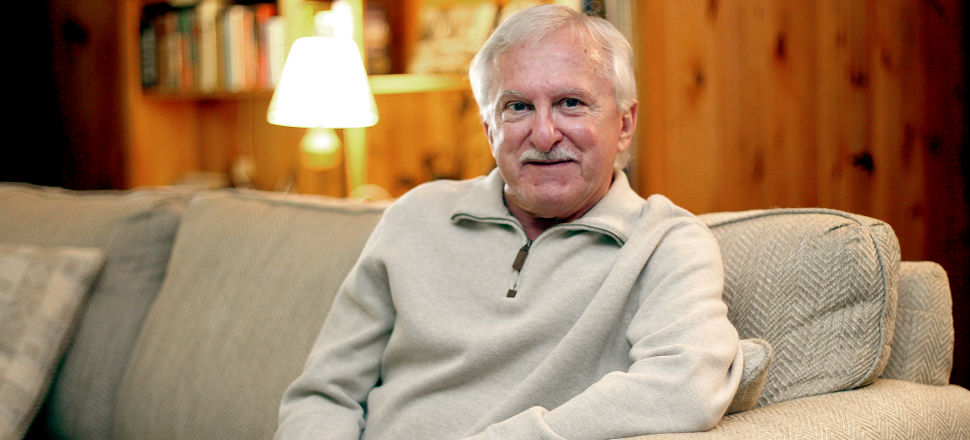
Paul Modrich. Image credit: AP Images
This may be a little unnerving if you think about it too hard, but the cells in your body are constantly dividing. Old cells die a programmed death, and new cells replace them. Although it’s not quite true that all your cells replace themselves every 7 years, many of the cells in your body do get replaced every 7 to 15 years.
Before a cell divides, it makes two copies of the DNA stored in its nucleus: one copy for each new cell. To do this, molecules in the nucleus rip apart the original strand of DNA and use its two halves as templates to build two new strands of DNA — a process called transcription. With trillions of cells in the body, each dividing every 7 to 15 years, and 3 billion base pairs in a strand of human DNA, there are a lot of chances for a tiny mismatch in transcription. And because we’re talking about your genetic code, a tiny mismatch can cause major problems in your body, such as cancer.
Fortunately, cells have a way of repairing transcription mismatches. Two enzymes, called MutS and MutL, move along the strand of DNA to detect mismatches. When they find a mismatch, another enzyme called MutH sorts out which strand is the original and which is the bad copy. How? The original strand will have methyl — groups of carbon and hydrogen atoms arranged in a particular way — attached to its outside, while the newer strand won’t. That’s because an enzyme called dam methylase attaches methyls to the outside of DNA strands, but it takes a while, so at first, the new strand won’t have any methyl attached. MutH cuts the mismatched section of the copy, and then DNA polymerase and DNA ligase patch up the cut in the usual way.
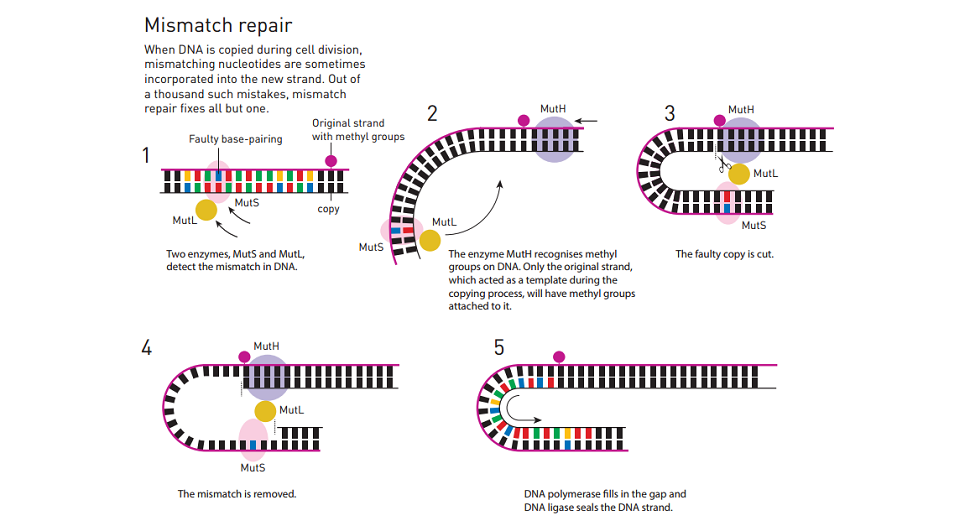
Mismatch Repair. Image Credit: Royal Swedish Academy of Sciences
Paul Modrich figured out this mechanism and published his discovery in 1989, and this year, he received a Nobel Prize for it. His research in the late 1980s included creating viruses with mismatches in their DNA and then infecting bacteria with them. Inside the bacteria, mismatch repair corrected the viruses’ DNA mismatches, but only on DNA strands with methyls attached — not on strands without methyls.
Some questions about mismatch repair are still unanswered. In humans, for example, the methyl on the outside of DNA strands has other functions, so biologists aren’t yet sure how mismatch repair enzymes tell the original DNA strand apart from the copy.
The Future of Genetics
Like all scientific discoveries, Lindahl, Sancar, and Modrich’s work built on the work of other scientists (many of whom are also Nobel laureates), and in turn, they have built a foundation of knowledge for future scientists.
Top image: Getty Images
